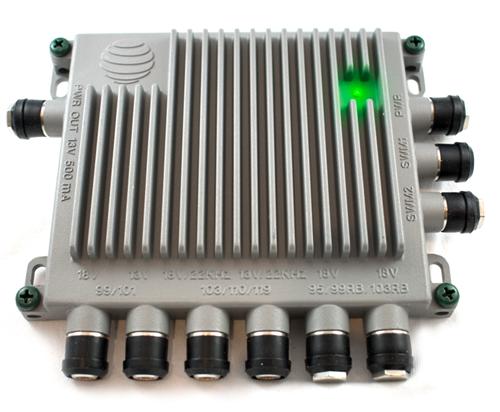This isn’t something you see every day, but lucky me, I get to work with a level of equipment that most people don’t ever see. For example, my tour many years ago of the DIRECTV Los Angeles Broadcast Center was pretty mindblowing. Not every piece of equipment is as sleek or cool as the stuff at LABC.
Let’s dig deep
I’d like to talk about polarity lockers. Polarity lockers are part of commercial systems, but you see them at home as well. They’re often paired with amplifiers to normalize the output from a satellite dish. This is done most often with commercial and industrial installations.
It’s easy to understand the need for an amplifier. Signal loss happens when cable runs are too long, and an amplifier is often necessary to make sure that satellite signals don’t get too weak before they get to a multiswitch. However, most people don’t understand polarity lockers and that’s a little harder to understand.
Did you ever wonder how the signal from all those satellites travels over a single wire? If you have a SWM-enabled dish, then the dish itself does all the work. However, a SWM dish isn’t allowed for commercial applications. For that you need a legacy dish with six wires coming out.
About those signals
The signals coming from the sky fall into six basic categories and the Slimline dish assigns a different “character” to each one. Without getting too technical, the signals from the 99 and 101 satellites act one way, and the signals from the other satellites act another way. Also, each satellite feed has two different “polarities,” which is a just a fancy way to describe the way the signals are put together. The lines coming from the dish can be of any one of four types (two satellites and two “polarities”) and in a simple system, the receivers request the kind of signal they want.
When using a single wire multiswitch, the switch itself will permanently assign each cable going the dish one of the four types. A polarity locker put closer to the dish does much the same thing, but by normalizing the signals closer to the dish, it makes everything more stable. This kind of stability is important when the dish feeds dozens or even hundreds of receivers.
How to connect it up
Connecting a polarity locker is easy. If you are using an amplifier, connect it before the polarity locker. Then, run four cables from the polarity locker to the amplifier. The outputs from the polarity locker are labeled by satellite and by odd or even polarity. Connect the cables from the polarity locker into the corresponding input ports on the SWM as follows:

First output [Output 1 (101E/99)] into Input 1 (99/101 18v)
Second output [Output 2 (101O/99)] into Input 2 (99/101 13v)
Third output [Output 3 (110E/103)] into Input 3 (103/110/119 18v 22KHz)
Fourth output [Output 4 (110O/103)] into Input 4 (103/110/119 13v 22kHz)
Fifth output [Output 5 (Flex1)] into input 5 (103RB 18v)
Sixth output [Output 6 (Flex2)] into input 6 (103RB 13v)
A system that is set up this way is more stable and better for long runs and multiple tuners. It’s also important to note that the polarity locker provides stable power to the dish meaning that the multiswitch doesn’t have to. Some multiswitches like the SWM-32 cannot provide power to the dish, while other multiswitches can. However, relying on the multiswitch to power the dish means that the multiswitch can’t be too far from the dish or the amount of voltage that reaches the dish might not be enough to power it. This is something to consider in large installations.
Shop at Solid Signal
Don’t try to get a “halfway” solution. Get the DIRECTV parts and accessories at the same place the professional installers shop… at SolidSignal.com.





